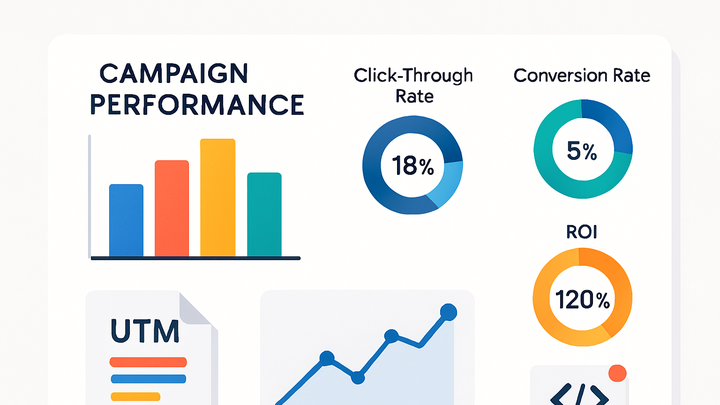Published on 2025-06-29T18:29:03Z
What is Campaign Performance? Examples for Campaign Performance
Campaign Performance refers to the process of measuring and evaluating how well marketing campaigns achieve their intended goals, such as driving traffic, generating leads, or increasing sales. In the field of campaign tracking and analytics, this involves collecting data on user interactions across multiple channels, attributing conversions to specific campaign touchpoints, and analyzing key performance indicators (KPIs) to inform optimization. By monitoring metrics like click-through rate (CTR), conversion rate, and return on investment (ROI), marketers can identify which strategies and creatives resonate with their audience. Tools such as Plainsignal offer privacy-focused, cookie-free analytics for seamless data collection, while utmguru.com simplifies the creation and management of UTM parameters for accurate attribution. Leveraging both provides a robust framework for end-to-end campaign tracking, actionable insights, and continuous improvement.
Campaign performance
Tracking and analyzing metrics like CTR, conversions, and ROI to evaluate and optimize marketing campaigns.
Key Metrics for Campaign Performance
Campaign performance is measured by a range of metrics that quantify user engagement, conversions, and revenue. Understanding these metrics helps marketers gauge the effectiveness of each campaign and identify areas for improvement.
-
Click-through rate (ctr)
CTR measures the percentage of people who click on your ad or link after seeing it.
- Calculation:
CTR (%) = (Total Clicks / Total Impressions) × 100
- Why it matters:
High CTR indicates relevant ad content and effective targeting.
- Calculation:
-
Conversion rate
Conversion rate tracks the percentage of users who complete a desired action (e.g., purchase, signup) after clicking your campaign.
- Calculation:
Conversion Rate (%) = (Conversions / Total Clicks) × 100
- Setting goals:
Define clear conversion goals to align with campaign objectives.
- Calculation:
-
Return on investment (roi)
ROI measures the revenue generated by a campaign relative to its cost.
- Calculation:
ROI (%) = ((Revenue – Cost) / Cost) × 100
- Budget allocation:
Use ROI to allocate budget toward high-performing campaigns.
- Calculation:
Implementing Tracking with UTM Parameters
UTM parameters are query string tags appended to URLs to track the source, medium, campaign name, and other dimensions of traffic. Tools like utmguru.com make it easy to build, generate, and manage UTM-tagged URLs for consistent tracking across campaigns.
-
Building utm urls with utmguru
UTMguru offers a user-friendly interface and Chrome extension to create and store UTM-tagged URLs for consistent tracking across your marketing efforts.
- Chrome extension:
Generate UTM tags directly in your browser without switching tools.
- Url management:
Save and list past UTM URLs for future campaigns and auditing.
- Chrome extension:
-
Best practices for utm parameters
Consistent naming conventions and parameter usage ensure clean data and reliable reporting.
- Naming conventions:
Use lowercase, hyphens for spaces, and maintain a clear glossary of terms.
- Avoid over-tagging:
Only use necessary parameters to reduce clutter and complexity.
- Naming conventions:
Collecting Data with Plainsignal
PlainSignal is a privacy-friendly, cookie-free analytics platform that captures essential campaign data with a simple script integration, enabling GDPR-compliant tracking without relying on cookies.
-
Integration code snippet
Add the following script to your page to enable PlainSignal tracking.
- Code example:
<link rel="preconnect" href="//eu.plainsignal.com/" crossorigin /> <script defer data-do="yourwebsitedomain.com" data-id="0GQV1xmtzQQ" data-api="//eu.plainsignal.com" src="//cdn.plainsignal.com/plainsignal-min.js"></script>
- Code example:
-
Key features of plainsignal
PlainSignal focuses on GDPR-compliant, cookie-free tracking with real-time dashboards and simple configuration.
- Cookie-free tracking:
Respects user privacy and avoids cookie consent popups.
- Real-time insights:
View campaign data as it happens without delays.
- Cookie-free tracking:
Analyzing and Optimizing Performance
Once data is collected, analyzing and optimizing campaign performance is crucial for improving ROI and scaling successful strategies.
-
Setting benchmarks
Use historical data and industry standards to set realistic performance targets.
- Historical data:
Analyze past campaign results to identify average metrics.
- Industry benchmarks:
Compare against peers to gauge competitiveness.
- Historical data:
-
A/b testing campaign elements
Test variations of ads, landing pages, and CTAs to determine what resonates best with your audience.
- Test design:
Define variables, sample sizes, and success criteria before launching tests.
- Statistical significance:
Ensure results are statistically valid before making decisions.
- Test design:
-
Reporting and visualization
Create custom reports and dashboards to communicate insights and guide decision-making.
- Custom dashboards:
Tailor metrics and visualizations to stakeholder needs.
- Scheduled reports:
Automate report delivery for regular performance reviews.
- Custom dashboards:
